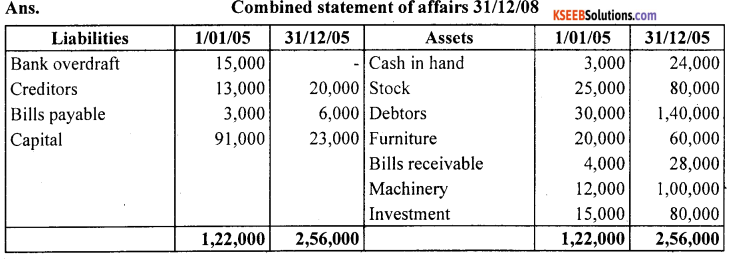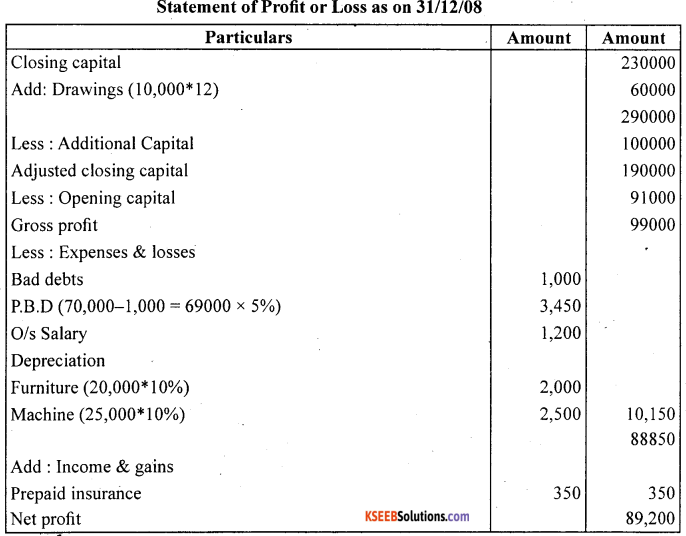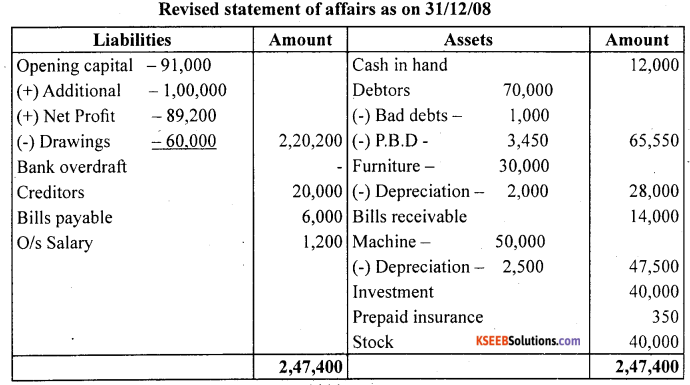You can Download Chapter 11 Accounts From Incomplete Records Questions and Answers, Notes, 1st PUC Accountancy Question Bank with Answers Karnataka State Board Solutions help you to revise complete Syllabus and score more marks in your examinations.
Karnataka 1st PUC Accountancy Question Bank Chapter 11 Accounts From Incomplete Records
1st PUC Accounts From Incomplete Records One Mark Questions and Answers
Question 1.
Write the meaning of Statement of affairs.
Answer:
It is just like a balance sheet. A statement which shows the values of Assets and Liabilities of a business on a given date. This statement helpful to find out capitals of a business.
Question 2.
What is Adjusted closing capital under Single Entry system?
Answer:
Under single entry system adjusted capital means, closing capital adjusted with drawings and additional capital called adjusted capital [Closing capital + Drawings – Additional Capital = Adjusted Capital).
Question 3.
What is the object of preparing statement of affairs?
Answer:
Single Entry System is incomplete, unscientific method of book keeping. For the purpose of finding out capital, Balance sheet equation is applied. The difference between Asset and Liability treated as capital [Assets – Liability = Capital].
Question 4.
If opening capital is ‘60,000, drawings ‘5,000, additional capital’ 10,000, closing capital ‘90,000, what will be the profit earned?
Answer:
Profit = Closing capital + Drawings – (Additional capital + Opening capital)
Profit = 90,000 + 5,000 – (10,000 + 60,000) Profit = 25,000.
![]()
Question 5.
Define Single Entry System.
Answer:
Prof: Eric Kholar defines Single Entry System as “a system of book keeping in which as a rule, only records of cash and persons are maintained; it is always in complete double entry, varying with circumstances”.
Question 6.
Write two features of Single Entry System.
Answer:
The two features of single entry system are.
(a) Both the aspect each and every transactions are not recorded under single entry system.
(b) Under this system all kinds of accounts are not maintained.
Question 7.
Mention any two merits of Single Entry System.
Answer:
The two advantages or merits of single entry systems are:
(a) It is a simple and easy method of book-keeping.
(b) It is less costly, because only few books of accounts are maintained.
Question 8.
State any Two de-merits of Single Entry System.
Answer:
Two disadvantages or demerits of single entry system is
- Both the aspects of each and every transactions are not recorded under this system. So it is incomplete system of records.
- Not possible to find out correct profit or loss of a concern.
Question 9.
Differentiate Single Entry System and Double Entry System.
Answer:
| Single Entry System | Double Entry System |
| 1. In this system each and every transactions are not recorded | 1. In this system both the aspects are recorded for every transactions. |
| 2. It is an incomplete, unscientific method of book-keeping | 2. It is a complete, scientific and satisfactory method of book-keep |
Question 10.
Mention the different types of Single Entry System.
Answer:
Three types of single entry systems are:
(a) Pure Single Entry System
(b) Simple Single entry system
(c) Quasi Single Entry system.
![]()
Question 11.
How do you ascertain profit or loss under Single Entry System?
Answer:
Under single entry system profit or loss of a concern can be found in two ways. They are Statement of Affairs method. Conversion of single entry to double entry system method.
Question 12.
Write the Balance Sheet Equation.
Answer:
Balance Sheet Equation.
Assets = Capital + Liability.
Question 13.
Differentiate Statements of Affairs and Balance sheet.
Answer:
| Statement of affairs | Balance sheet |
| 1. It is prepared under single entry system | 1. It is prepared under double entry system |
| 2. It states estimated value of assets and liabilities. | 2. It states real value of assets and liabilities of a business concern |
Question 14.
What is statement of Profit or Loss?
Answer:
Statement of Profit or Loss is a statement prepared under single entry system. It is prepared for the purpose of ascertaining Profit or Loss of a business in a given period.
Question 15.
How do you calculate gross profit under single entry system?
Answer:
The differences between closing capital and opening capital adjusted with additional capital and drawings called Gross profit or gross loss [closing capital + drawings – Additional capital – opening capital = gross profit]
Question 16.
Mention the books maintained under Single Entry System.
Answer:
The books maintained under single entry system are
(a) Cash Book
(b) Debtors and Creditors personal a/c
(c) Few Subsidiary books.
Question 17.
Write any Four examples of Assets mentioned in statement of Affairs.
Answer:
The assets recorded in statement of affairs are: Land and Building, Machinery, Debtors and Cash are Four Examples of Assets.
Question 18.
Write any Four examples of income consider while preparing statement of Profit or Loss.
Answer:
Income recorded in statement of profit or loss are:
(a) Rent Receivable
(b) Commission receivable
(c) Appreciation of Building
(d) Insurance prepaid.
![]()
Question 19.
State the meaning of incomplete records?
Answer:
Accounts that are not recorded as per the double entry system are known as incomplete records. According to Kohler (Dictionary for Accountants), single entry system is defined as, “A system of book-keeping in which as a rule, only records of cash and of personal accounts are maintained; it is always incomplete double entry, varying with circumstances.”
1st PUC Accounts From Incomplete Records Additional Questions
Question 1.
What are dis-advantages of single entry system?
Answer:
The important de-merits of incomplete records are
a. Under incomplete records arithmetical accuracy cannot be checked
b. Due to incomplete records, there will be scope and mis appropriation of funds.
c. Not possible to finitude true profit or loss of a business concern.
d. It never disclose correct financial position of a business concern.
e. This system not reliable by legal authority.
Question 2.
What are the differences between double entry system and single entry system?
Answer:
The important de-merits of incomplete records are:
| Single Entry System | Double Entry System |
| 1. Treated as unscientific or incomplete methods of book keeping | 1. Treated as complete and scientific method of book keeping |
| 2. The purpose of preparing is to ascertain capital as on particular date. | 2. The purpose of preparing is to find out financial position of the concern. |
| 3. It shows only the estimated financial position of the concern. | 3. It shows realistic financial position for a given period |
| 4. Om mission of Assets and liabilities cannot be easily traced | 4. Any missing items can be easily traced. |
| 5. It is prepare with the help of some ledger a/c and statements. | 5. It is prepared on the basis of ledger a/c balances. |
Question 3.
Write the Advantage / Merits of incomplete’records system.
Answer:
The important uses/merits of incomplete records are:
- It is a simple and easy method of book – keeping.
- It is less costly, because only few books of accounts are maintained.
- Only personal and cash accounts are main trained.
- It is suitable for small business concern.
- Accounting knowledge is not much required
Question 4.
Explain the procedure of ascertaining profit under incomplete records.
Answer:
The steps or procedure for finding out profit under incomplete system of book keeping. Closing Capital Add: Drawings
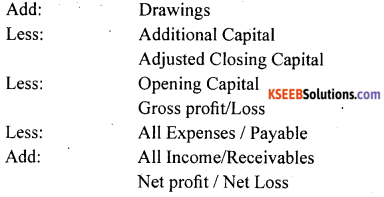
Question 5.
Explain the special features of accounts from incomplete records.
Answer:
Special features of accounts from incomplete records are:
- Both the aspect of each and every transactions are not recorded.
- Under this system all kinds of accounts are maintained.
- It is simple and easy method of book keeping.
- It is less costly.
- It is not very supportive to find out exact profit of the business concern.
- Not possible to find out correct profit or loss of a concern.
![]()
Question 6.
Aniketh gives you the following information. Find out his profit or loss.
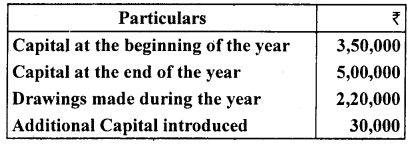
Answer:
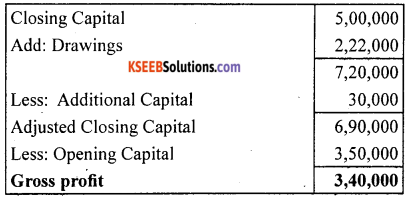
Question 7.
Manmohan started his business on 01.01.2008 with a capital of ₹ 4,50,000. On 31.12.2008, his position was as under:
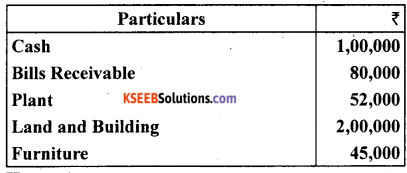
He owed ₹ 30, 000 to his friend Ashok on th at date. He withdrew ₹ 6,000 p.m. for his household purposes. Ascertain his profit or loss for the year ending 31.12.2008.
Answer:
Opening Capital 4,50,000
Closing Capital = Assets – Liability
4,77,000 – 30,000 = 4,47,000
Drawings = 6,000 × 12 = 72,000
Additional Capital = W.L
Profit =. 4,47,000 + 72,000 – 4,50,000 = 69,000
Question 8.
From the following, calculate the capital at the beginning:
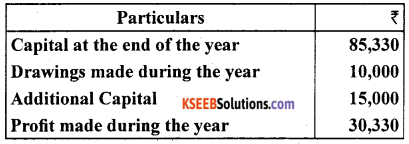
Answer:
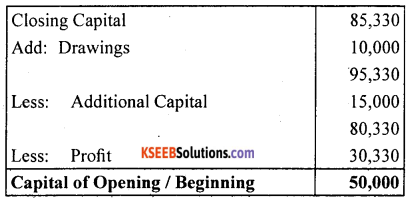
![]()
1st PUC Accounts From Incomplete Records Six Marks Questions and Answers
Question 1.
What are the possible reasons for keeping incomplete records?
Answer:
The possible reasons for keeping incomplete records are:
a. Simple method: Proprietors, who do not have the proper knowledge of accounting principles, find it much convenient and easier to maintain their business records under this system.
b. Less time consuming: Maintaining books according to the single entry system is less time consuming, as only few books are to be maintained. Further, the books are not as comprehensive as they are under double entry system.
c. Less expensive: It is an economical mode of maintaining records, as there is no need to appoint specialized accountant.
d. Flexible: Owner may record transactions as per his/her own needs. It can be easily adjusted or changed whenever needed.
Question 2.
Distinguish between statement of affairs and balance sheet.
Answer:
| Basis of Difference | Statement of Affairs | Balance Sheet |
| Objective | It is prepared to determine the amount of capital at a particular date. | It is prepared to ascertain the true financial position. |
| Reliability | It is bases on estimates; hence, it is less reliable. | It is based on sophisticated and well developed principles; hence, it is more |
| Accounting Method |
It is prepared from incomplete records of business transactions under single entry |
It is prepared when accounts are maintained under double entry system. |
| Omission | Omission of assets and liabilities cannot be easily identified. | Omission of assets and liabilities can be easily identified, as omission will lead to mismatch of either sides of the balance sheet. |
Question 3.
What practical difficulties are encountered by a trader due to incompleteness of accounting records?
Answer:
The following are the difficulties that are encountered by a trader due to incompleteness of accounting records:
a. Accuracy of accounts: Arithmetical accuracy of accounts cannot be ascertained, since proper records of accounts are not maintained. Consequently, Trial Balance cannot be prepared.
b. Encourages fraud: As the arithmetical accuracy cannot be determined; so, this encourages fraud and provides sufficient scope for bluffing and carelessness.
c. Difficult to ascertain correct profit or loss: Since all expenses and income are not recorded, true profit or loss cannot be correctly ascertained.
d. Difficult to analyse the true financial position: As profit or loss cannot be ascertained. easily, so the balance sheet cannot be easily prepared. Hence, the absence of balance sheet will not reflect the true financial position of the business.
e. Difficulty in comparison: Due to the incomplete records and non-availability of previous years’ data, comparison is not possible. By the same token, comparisons with other firms are also not possible.
f. Unacceptable to tax authorities: It does not reflect the true and acceptable presentation of expenses and revenues. Hence, these are not acceptable by the tax authorities.
g. Raising funds: Since analysis of solvency, profitability and liquidity of business cannot be done, it is difficult to raise fund from outside.
![]()
1st PUC Accounts From Incomplete Records Twelve Marks Questions and Answers
Question 1.
What is meant by a ‘statement of affairs’? How can the profit or loss of a trader be ascertained with the help of statement of affairs?
Answer:
Statement of Affairs is like a balance sheet, which shows the estimated values of assets and liabilities.
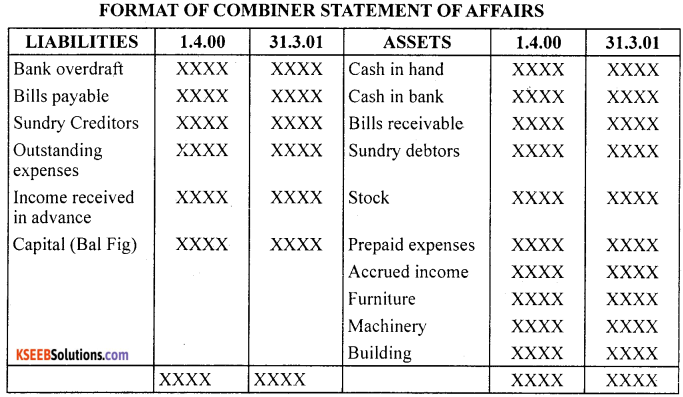
Question 2.
When liabilities are more than assets, then the balancing figure is denoted by Capital Deficiency in the assets side of the statement of affairs.
Answer:
When the assets’ balance exceeds liabilities’ balance, the balancing figure is denoted by capital in liabilities side of the statement of affairs.
For ascertaining profit or loss, if capital in the beginning is not given, then opening statement of affairs is prepared in order to calculate the capital in the beginning. Once the opening capital and closing capital is calculated, as Statement of profit or loss is prepared to determine the amount of profit earned or loss incurred during the accounting period.

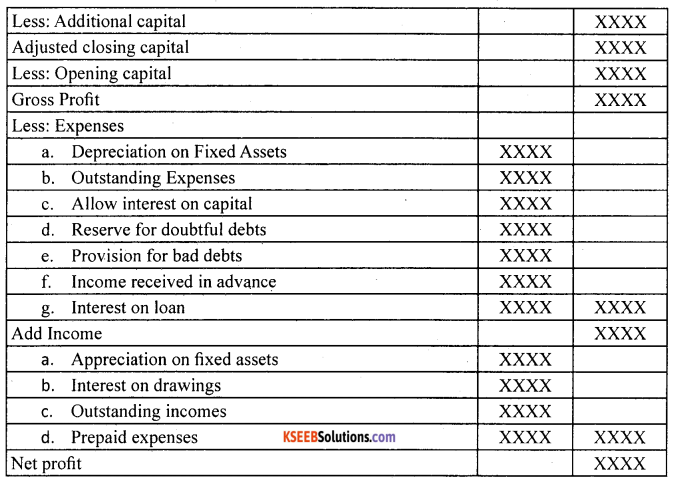
Question 3.
Is it possible to prepare the profit and loss account and the balance sheet from the incomplete book of accounts kept by a trader? Do you agree? Explain.
Answer:
The profit and loss account and the balance sheet can be prepared from the incomplete book ‘ of accounts through Conversion method. According to this method, incomplete records are converted into double entry records. In case of incomplete records, details of some transactions are easily available like cash sales, cash purchases, creditors, debtors; however, there are number of transactions, the details of which may not be available directly. Yet, these details can be found out indirectly or logically. Some of the important items that are vital for preparing balance sheet are given below,
a. Opening capital
b. Closing capital
c. Credit purchases
d. Cash purchases
e. Credit sales
f. Cash sales
g. Payment from debtors
h. Payment to creditors
i. Opening stock
j. Closing stock
Below are given are the steps included in the conversion method in a chronological order:
a. If opening capital is not given, then the first step is to prepare opening statement of affairs that gives the opening capital.
b. The second step is to prepare cash book that gives the opening or the closing cash and bank balancer.
c. The next step is to prepare total debtors account. It is prepared in order to find one of the missing figures, such as credit sales, opening debtors, closing debtors and cash received from debtors.
d. The subsequent step is to prepare total creditors account to ascertain one of the missing figures, such as credit sales, opening creditors, closing creditors and cash paid to the creditors.
e. The last step is to prepare final accounts. On the basis of the missing figures ascertained in each of the above steps, along with other mentioned information, Trading and profit and loss account and balance sheet can be prepared.
![]()
Question 4.
Explain how the following may be ascertained from incomplete records:
a. Opening capital and closing capital
b. Credit sales and credit purchases
c. Payments to creditors and collection from debtors
d. Closing balance of cash.
Answer:
a. Opening capital and closing capital: Opening capital can be ascertained by preparing opening statement of affairs at the beginning of the accounting period and closing capital can be ascertained by preparing closing statement of affairs at the end of the accounting period.
b. Credit sales and credit purchases: Credit sales are ascertained as the balancing figure of the total debtors account and credit purchases are ascertained as the balancing figure of the total creditors account.
c. Payments to creditors and collection from debtors can be ascertained by preparing total creditors account and total debtors account respectively.
d. Closing balance of cash may be ascertained by preparing cash account.
Question 5.
M/s Saniya sports equipment does not keep proper records. From the following information find out profit or loss and also prepare balance sheet for the year ended December 31, 2005
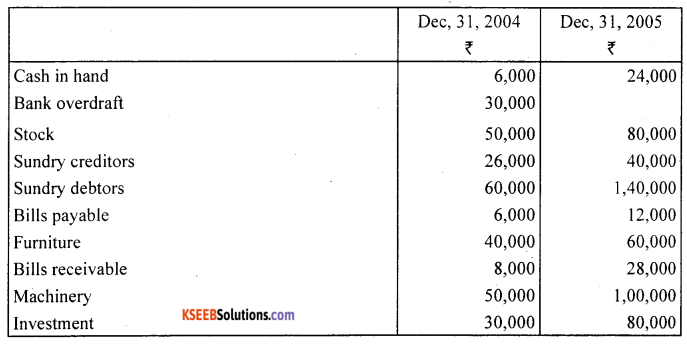
Drawings ₹ 10,000 p.m. for personal use, fresh capital introduce during the year ₹ 2,00,000. A bad debts of ₹ 2,000 and a provision of 5% is to be made on debtors. Outstanding salary ₹ 2,400, prepaid insurance ₹ 700, depreciation charged on furniture and machine @ 10% p.a.
Question 6.
From the following information calculate the amount to be paid creditors: ?
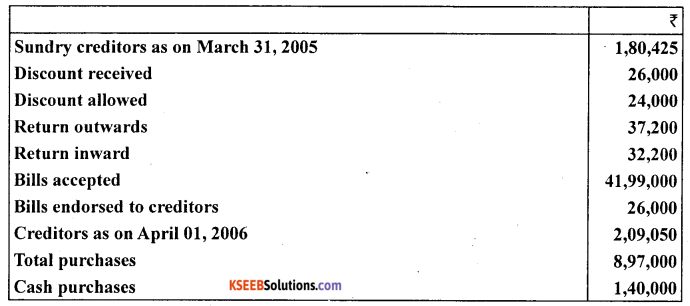
Answer:
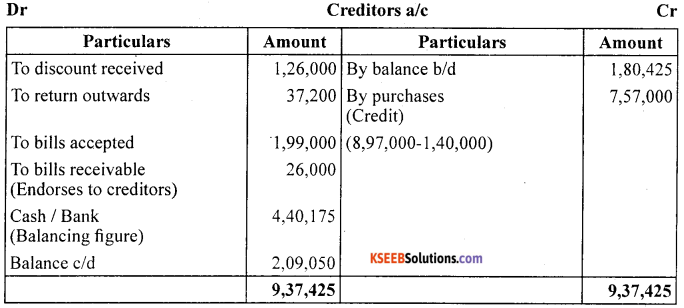
Cash paid to creditors = 4,40,0175
Question 7.
Find out the credit purchases from the following: ?


Answer:
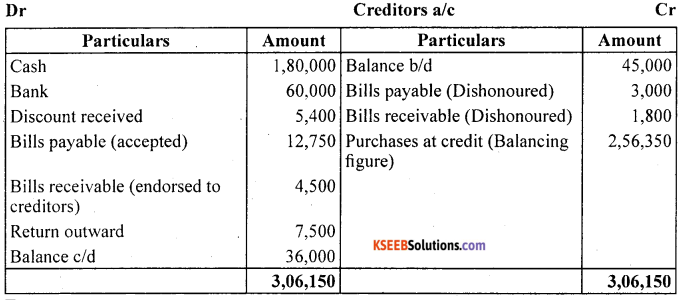
![]()
Question 8.
From the following information calculate total purchases. ?
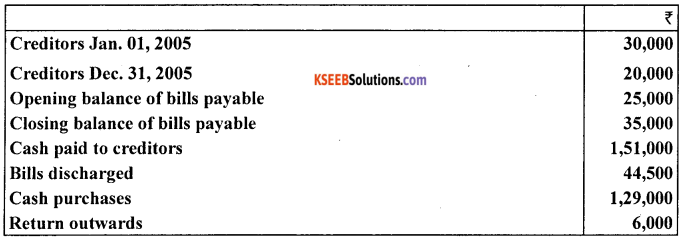
Answer:


Total purchase = Cash purchase + credit purchases = 1,29,000+2,01,500 = 3,30,500
Question 9.
The following information is given ?

Answer:

Question 10.
From the following, calculate the amount of bills accepted during the year.

Answer:

Calculated purchases during the year
Question 11.
Find out the amount of bills matured during the year on the basis of information given below :

Answer:

Question 12.
Prepare the bills payable account form the following and find out missing figure if any:
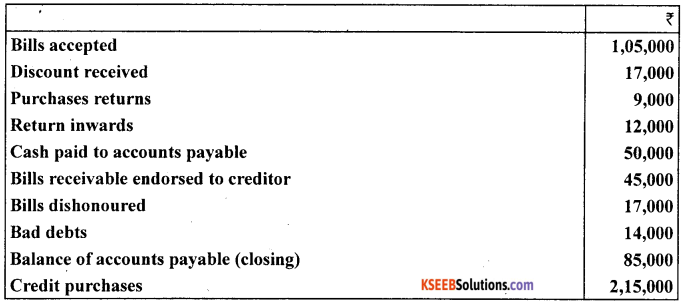
Answer:
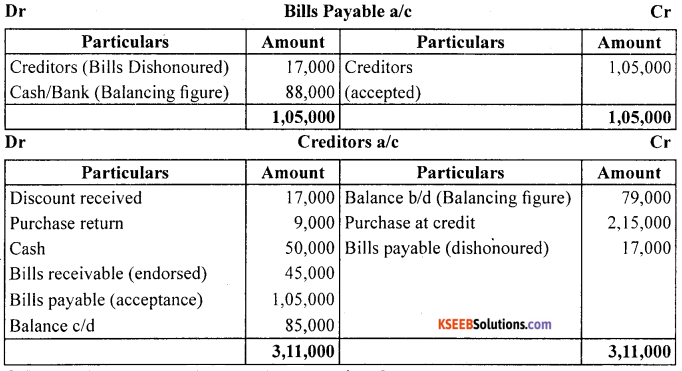
![]()
Question 13.
Calculate the amount of bills receivable during the year. ?

Answer:

Question 14.
Calculate the amount of bills receivable dishonoured from the following information. ?

Answer:

Question 15.
From the details given below. Find out the credit sales and total sales.
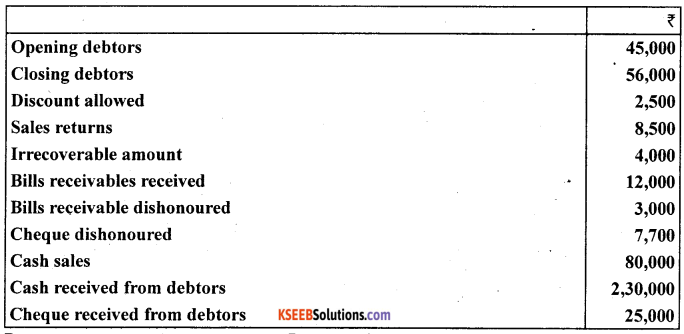
Answer:
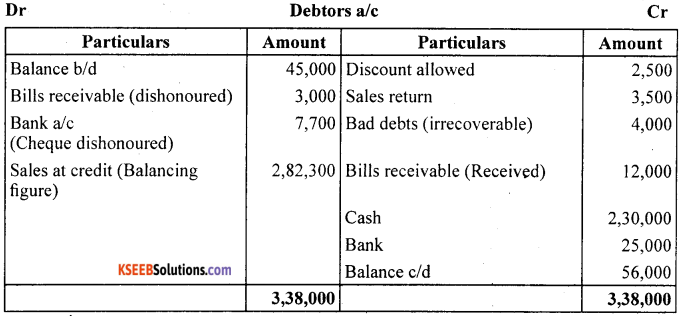
Total sales = cash sales + credit sales
= 80,000 + 2,82,300
= 3,62,300
Question 16.
From the following information. Prepare the bills receivable account and total debtors account for the year ended December 31, 2005.
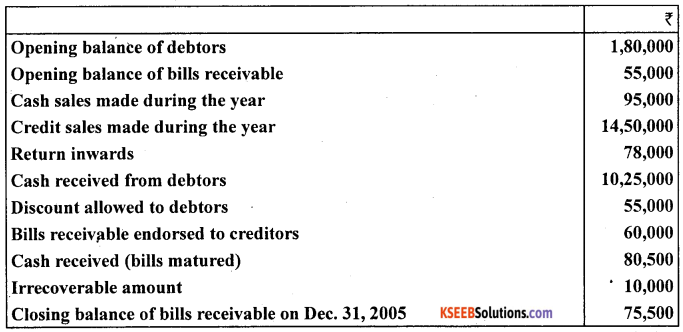
Answer:
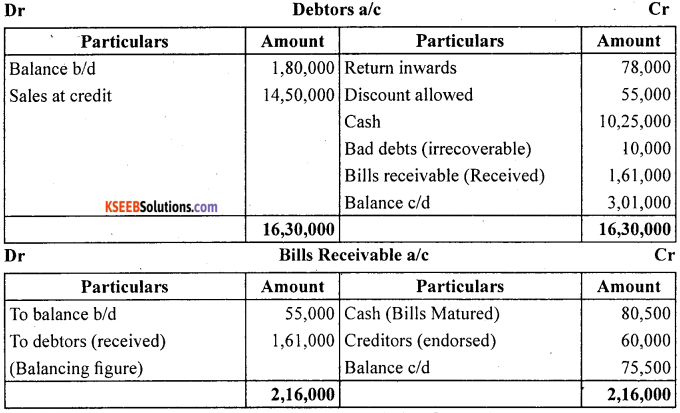
![]()
Question 17.
prepare the suitable accounts and find out the missing figures if any ?

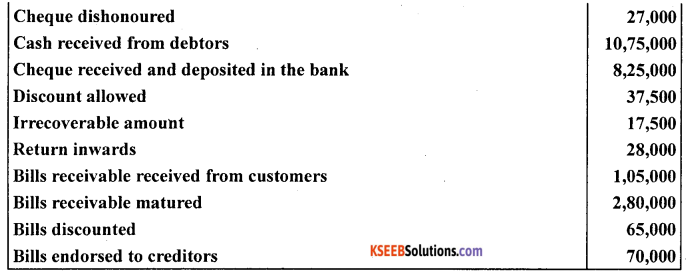
Answer:

Question 18.
From the following information ascertain the opening balance of sundry debtors and closing balance of sundry creditors.

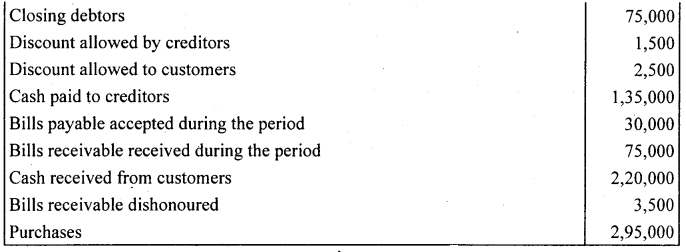
The rate of gross profit is 25% on selling price and out of the total sales ₹ 85,000 was for cash sales.
(Hint: Total sales = 4,00,000 = 3,00,000*100/75)
Answer:
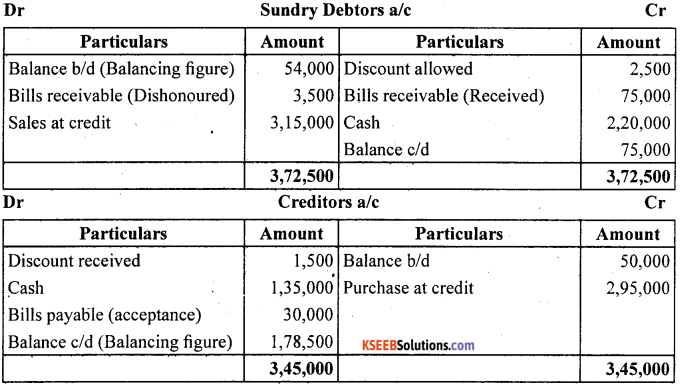
Total sales = Cash sales + Credit sales
Total sales = cost of goods sold + Gross profit
Cost of goods sold = opening stock + purchases – closing stock
= 30,000 + 2,95,000 – 25,000
= 3,00,000
Gross profit is 25% on sales i.e. 1/4 on sales so 1/3 on cost i.e. 1/4-1 = 1/3
Gross profit = 3,00,000 * 1/3 = 1,00,000
Total sales = 3,00,000 + 1,00,000
= 4,00,000
Total sales = cash sales + credit sales
4,00,000 = 85,000 + credit sales
Credit sales = 4,00,000 – 85,000
= 3,15,000
Question 19.
Mrs. Bhavana keeps his books by single entry system. You’re required to prepare final accounts of her business for the year ended December 31,2005. Her records relating to cash receipts and cash payments for the above period showed the following particulars:
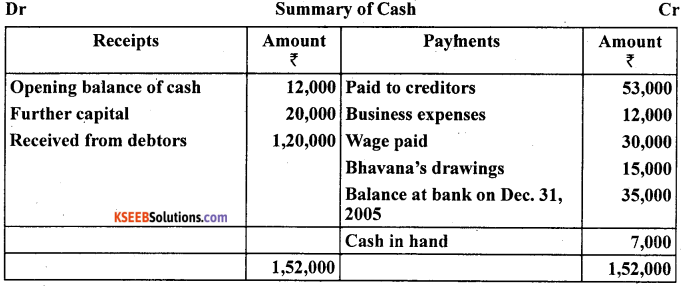
The followng information is also avaliable:
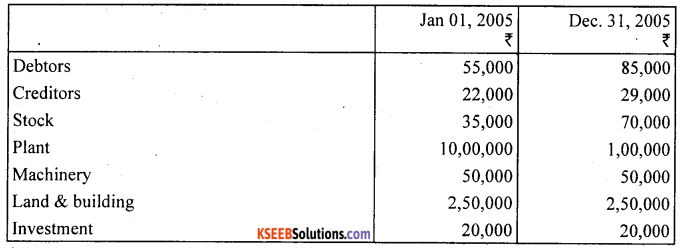
All her sales and purchases were on credit. Provide depreciation on plant and building by 10% and machinery by 5%, make a provision for bad debts by 5%.
(Ans : Gross profit: ₹ 95,000 ; Net profit: ₹ 41,250 : Total of balance sheet: ₹ 5,75,250).
![]()
1st PUC Accounts From Incomplete Records Numerical Questions
Ascertainment of profit or loss by statement of affairs method
Question 1.
Following information is given below prepare the statement of profit or loss: Capital at the end of the year ?

Answer
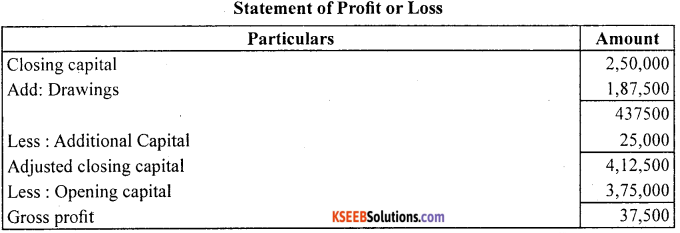
Question 2.
Ramesh started his business on January 01, 2005 with a capital of ₹ 2,25,000. On December 31,2005 his position was as under: ?

He owned ₹ 22,500 from his friend Susheel on that date. He withdrew ₹ 4,000 per month for his household purposes: Ascertain his profit or loss for this year ended December 31, 2010.
Answer:


Question 3.
From the information given below ascertain the profit for the year : ?
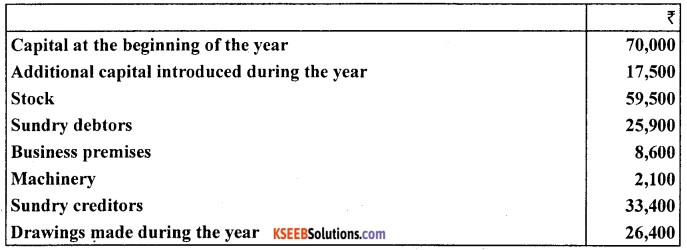
Answer:
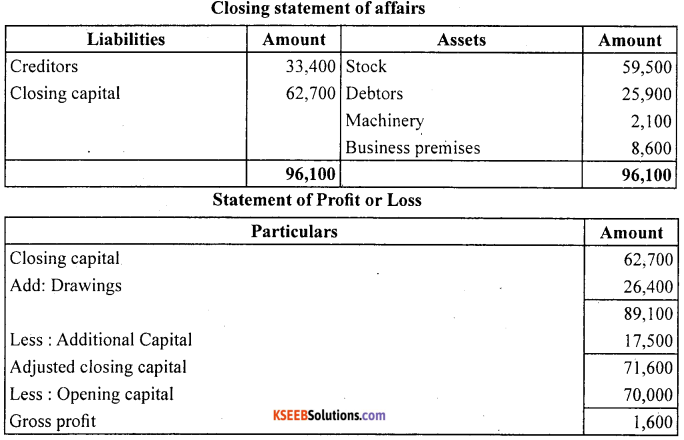
Question 4.
From the following information, calculate capital at the beginning :

Answer:
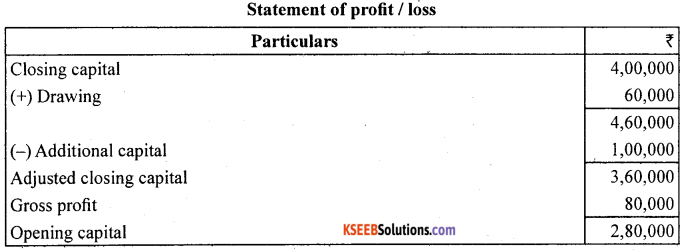
![]()
Question 5.
Following information is given below : calculate the closing capital

Answer:

Closing Capital = 40,000

Question 6.
Mrs. Manu started firm with a capital of ₹ 4,00,000 on 1st July 2005. She borrowed from her friends a sum of ₹ 1,00,000 @ 10% per annum (interest paid) for business and brought a further amount to capital ₹ 75,000 on Dec. 31, 2008, her position was:c?

He withdrew ₹8,000 per month for the year. Calculate profit or loss for the year and show your working clearly.
Answer:

Question 7.
Mr. Rakesh does not keep proper records of his business he provided following information, you are required to prepare a statement showing the profit or loss for the year. ?


Ascertainment of statement of affairs at the beginning and at the end of the year and calculation of profit or loss.
Answer:
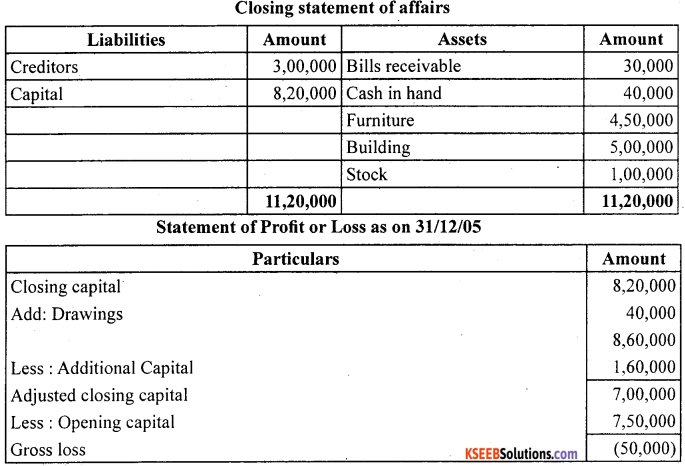
Question 8.
Mr. Akash keeps his books on incomplete records following information is given below :


During the year he withdrew ₹ 22,500 and introduced ₹ 12,500 as further capital in the business compute profit or loss of the business.
Answer:

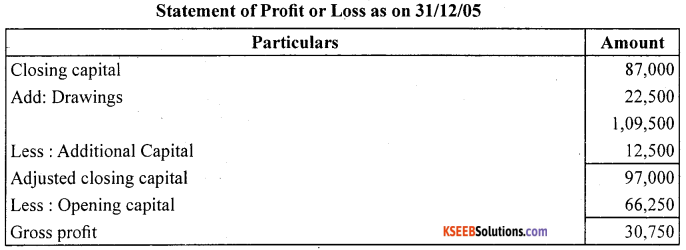
![]()
Question 9.
Krishna does not keep proper books of account. Following information is given below:
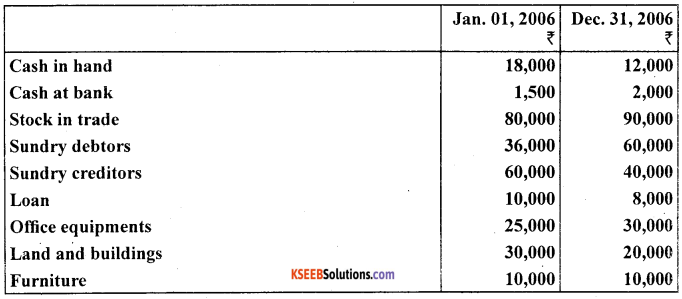
During the year he introduced ₹ 20,000 and withdrew ₹ 12,000 from the business. Prepare the statement of profit or loss on the basis of given information Answer:
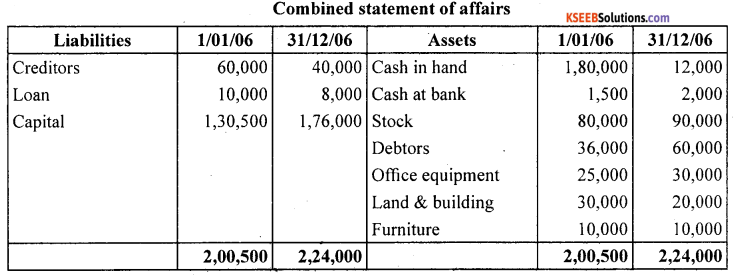
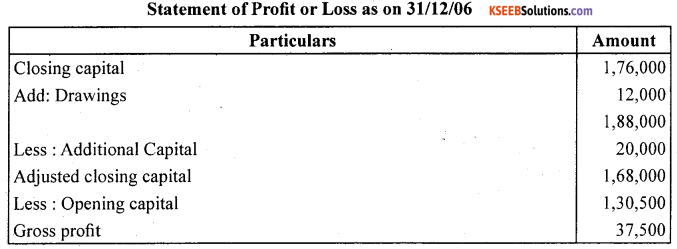
Question 10.
Mr. Mahesh maintains his books of accounts from incomplete records. His books provide the information :
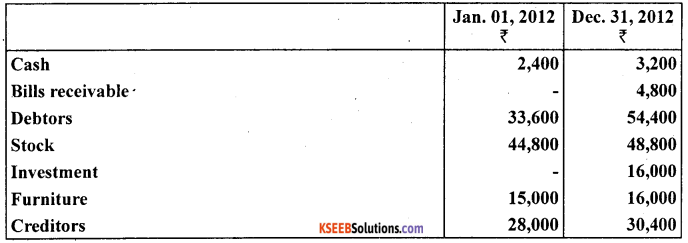
He withdrew ₹ 600 per month for personal expenses. He sold his investment of ₹ 32,000 at 2% premium and introduced that amount into business.
Answer:
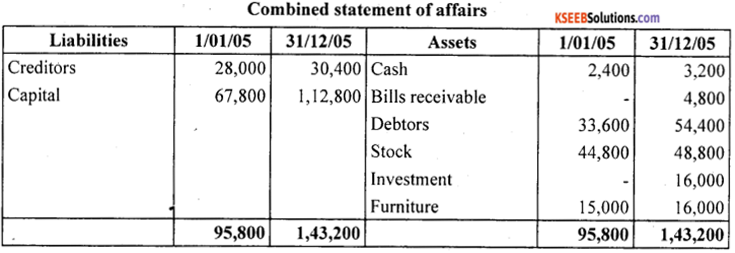
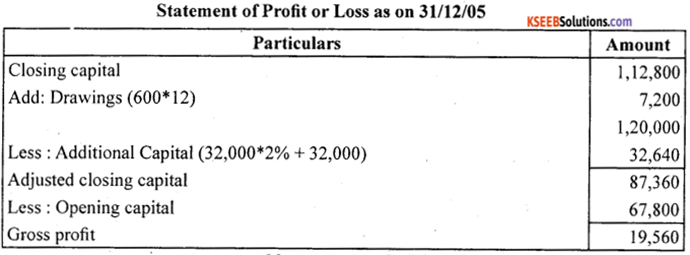
Question 11.
Mr. Rajesh does not keep full double entry records. His balance as on January 01,2013 is as.
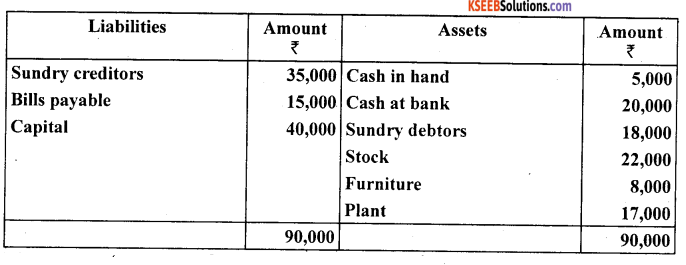
Answer:


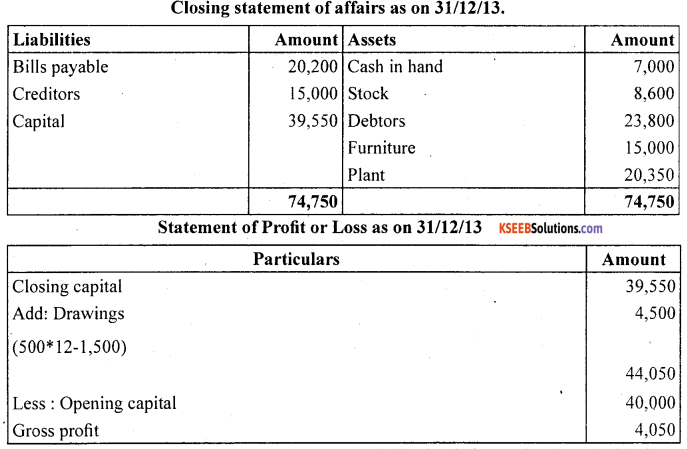
![]()
Question 12.
Mr. Santhosh does not keep his books properly. Following information is available from his books.
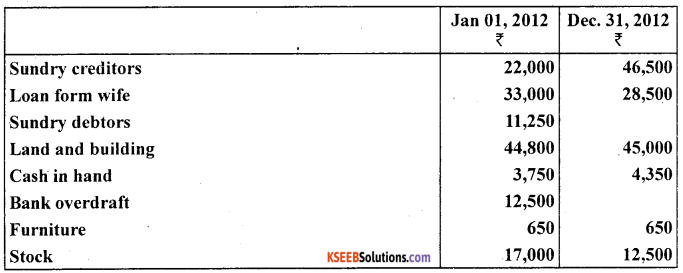
During the year Mr. Santhosh sold his private car for ₹ 25,000 and invested this amount into the business. He withdrew from the business ₹ 750 per month upto July 31,2012 and thereafter ₹ 2,250 per month as drawings. You are required to prepare the statement of profit or loss and statement of affair as on December 31,2005.
Answer:
His position at the of the year is:
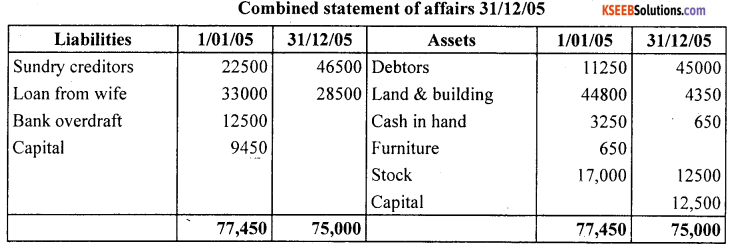
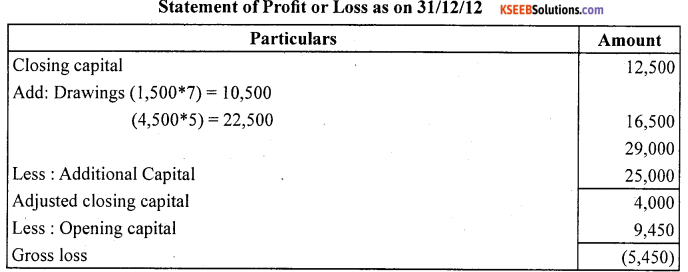
Question 13.
Ms. Sahand has not kept proper books of accounts prepare the statement of profit or loss for the year ending December 31,2008 from the following information:
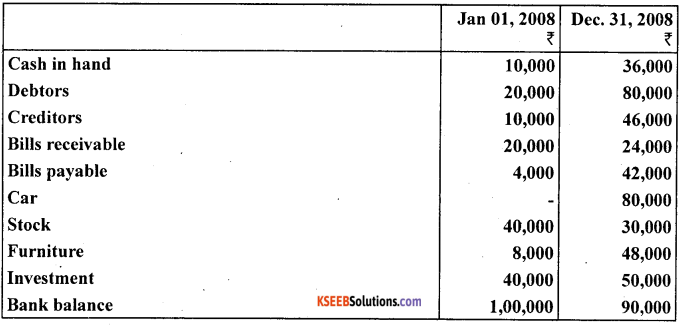
The following adjustments were made:
(a) Ms Sahana withdrew cash ₹ 5,000 per month for private use.
(b) Depreciation @ 5% on car and furniture @ 10%.
(c) Outstanding Rent ₹ 6,000
(d) Fresh capital introduced during the year ₹ 30,000.
Answer:
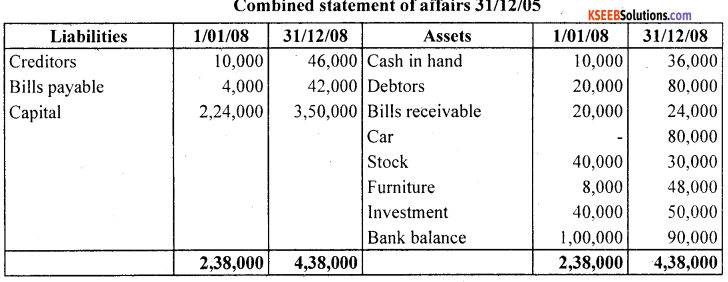
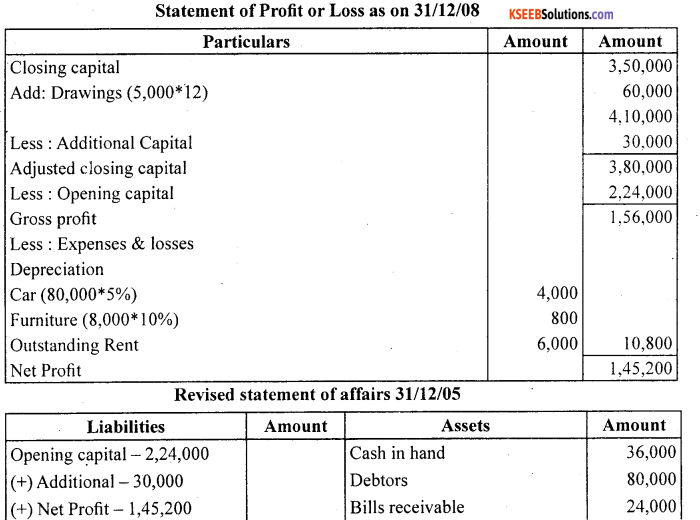

![]()
Question 14.
M/s Soniya Sports Equipment does not keep proper records. From the following information find out profit or loss and also prepare balance sheet for the year ended December 31,2004.
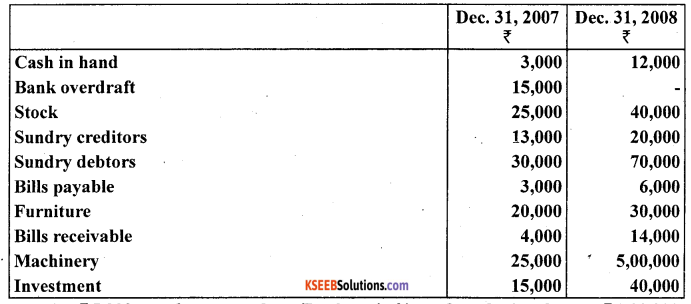
Drawing ₹ 5,000 p.m. for personal use. Fresh capital introduce during the year ₹ 1,00,000. A bad debts of ₹ 1,000 and a provision of 5% is to be made on debtors. Outstanding salary ₹ 1,200, prepaid insurance ₹ 350. Depreciation charged on furniture and machine @ 10% p.a.
Answer:
